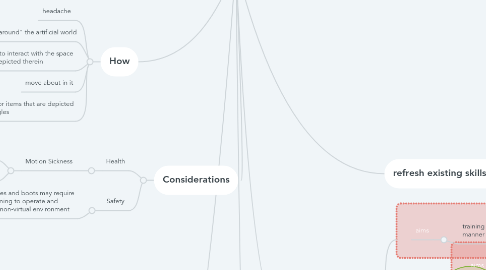
1. Definition
1.1. artificial environment created with software
1.2. mainly experienced by sight and sound on the computer
1.3. make people believes and accepts the VR as a real environment
2. History
2.1. 1838-Stereoscopic photos & viewers
2.2. 1929 – Link Trainer The First Flight Simulator
2.3. 1930s – Science fiction story predicted VR
2.4. 1950s – Morton Heilig’s Sensorama
2.5. 1960s
2.5.1. The first VR Head Mounted Display
2.5.2. Headsight – First motion tracking HMD
2.5.3. The Ultimate display by Ivan Sutherland
2.5.4. Sword of Damocles
2.5.5. Artificial Reality
2.6. 1987-Virtual reality the name was born
2.7. 1990s
2.7.1. Virtuality Group Arcade Machines
2.7.2. The Lawnmower Man
2.7.3. SEGA announce new VR glasses
2.7.4. Nintendo Virtual Boy
2.7.5. The Matrix
3. How
3.1. headache
3.2. able to "look around" the artificial world
3.3. enabling the user to interact with the space and any objects depicted therein
3.3.1. using specialized display screens or projectors and other devices
3.4. move about in it
3.5. interact with features or items that are depicted on a screen or in googles
4. Considerations
4.1. Health
4.1.1. Motion Sickness
4.1.1.1. general discomfort
4.1.1.2. fatigue
4.2. Safety
4.2.1. pecialized gloves and boots may require specialized training to operate and navigating the non-virtual environment
4.2.1.1. might prove dangerous without external sensory information.
5. In Military
5.1. aims
5.1.1. training soldiers to react in an appropriate manner in some dangerous setting
5.2. examples
5.2.1. Flight simulation
5.2.2. Battlefield simulation
5.2.3. Medic training
5.2.4. Vehicle simulation
5.2.5. Virtual boot camp
6. refresh existing skills in safe environment
7. Application
7.1. In Education
7.1.1. aims
7.1.1.1. In Education
7.1.2. examples
7.1.2.1. Surgery simulation
7.1.2.2. Three dimensional images
7.2. In Healthcare
7.2.1. aims
7.2.2. examples
7.2.2.1. Surgery simulation
7.2.2.2. Phobia treatment
7.2.2.3. Robotic surgery
7.2.2.4. Skills training
7.3. In Entertainment
7.3.1. aims
7.3.1.1. learn new skills without causing any danger to the patients
7.3.1.2. enable members of the public to engage with the exhibits in ways which were previously forbidden or unknown
7.3.2. examples
7.3.2.1. CAVE systems
7.3.2.2. augmented reality systems
7.3.2.3. 3D display platform
7.4. In Engineering
7.4.1. aims
7.4.1.1. saves both time and money.
7.4.2. examples
7.4.2.1. 3D modelling
7.4.2.2. visualization techniques
7.5. In Sport
7.5.1. aims
7.5.1.1. help athlete practice
7.5.2. examples
7.5.2.1. Virtual reality performance

